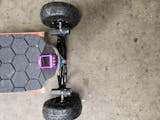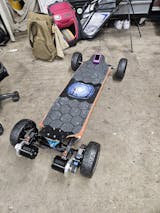How to Ride an Electric Bike in Traffic
Riding an electric bike is an effective way to navigate busy city streets, whether you're running an errand, or bypassing other forms of transportation to shorten your commute. In big cities like New York, traffic safety is a massive issue for motorists due to the dense population and crowded streets. Native New Yorkers aren't phased by swift, close encounters. Still, outsiders will need to get used to the hyper-vigilance and aggressive maneuvering. If it's barely safely for motorists in big cities, how would you approach carefully navigating city streets on electric bikes?
There are plenty of concepts that you need to be familiar with as you take to the road. Like any other skill set, practice is imperative. Here are some universal tactics to keep you safe while riding in traffic. To be sure, there are nuances associated with riding in different areas. Some cities have thoughtfully designed bike lanes, while older cities may barely have shoulders for you to use. Regardless of your unique circumstances, these tips will give you a great foundation to show you how to stay safe in traffic.
How to Stay Safe in Traffic
As long as you start with an awareness of your surroundings and the proper safety considerations, you will improve your bike safety by actually riding in traffic. The more you do it, the better you’ll get at it.
Plan your route
From the start, make an effort to select the safest route. If you’re going to work, consider traveling on side streets with fewer cars or opting for established bike lanes if they’re available. Since it’s generally safer to make right turns than left turns that fully expose you to intersections, factor that into your planning, too. If you’ll pass a lot of parked cars, keep an eye out for taillights and occupied vehicles. Doors that open directly in front of you pose a real problem for cyclists since you have little time to react.
Go with the flow
The first consideration is that you want to be in the flow of traffic. Make sure that you’re moving with the cars on the right side of the road. Although it depends on your local laws, most states require that you ride as far to the right as is safely possible. Ideally, that means just outside of the shoulder, but if you need to avoid an obstacle in front of you, head to a more central lane to avoid it. If you have to do this, use a hand signal before you head in. Unfortunately, lots of cities prohibit adults from riding on sidewalks, so double-check the biking laws where you ride.
Use your hand signals
In drivers' ed, you learn hand signals to use if you find yourself in a situation where the blinker on your car doesn't work. Those hand signals are easily recognized and often used by bikers. To turn left, fully extend your left arm in a straight line from your shoulder. To turn right, put a 90-degree bend in your left your elbow. For cyclists, it's also acceptable to fully extend your right arm, indicating a right turn. (You wouldn't be able to see a straight right arm from a person driving a car, hence the 90-degree bend.)
You can also signal a stop or that you're slowing down by extending either arm down by your side at a 45-degree angle. Make sure that you rotate your hand so that it faces the motorist or cyclist that you're trying to signal. To signal a turn, check your mirrors if you have them, and wait for a clear spot. Once you see one, signal, move over and get back to the right side of the road as soon as possible.
Make yourself visible…
Cars are allowed to pass you on the road and generally possess the right of way. Still, most states specify that drivers must give you three to six feet of space. While that may feel close in tight pockets of traffic, it’s still enough to keep you safe.
It’s always a good idea to acknowledge drivers as you ride your electric bike. You can take a quick glance over your shoulder to make sure that the driver is aware that you’re sharing the road with them, or even wave them on if they make you uncomfortable as they wait to pass you. Though they most likely won’t hear you, you can talk out loud. Some drivers can read your lips, but even if they can’t, they’ll pay more attention to you if that movement catches their eye.
If you’re riding on a greenbelt or trail with other cyclists, rollerbladers, or people out for a walk or a jog, ding a bell as you approach. Give walkers as wide a berth as you can. When you’re within earshot, let them know that you’ll be passing on the left or whatever they need to know. People riding traditional bikes may be jealous of the speed of an electric bike. Be polite!
Flashing lights on the front and back of your bike are helpful in the daytime. Or you can choose to wear a reflective vest, stripes, leg bands, or even bright socks. Bonus points if you get fitted for a well-fitted helmet in a bright, flashy color. Oh, and since it can't be overstated—make sure that you’re wearing a helmet! As countless studies have proven, helmets are vital for cyclists’ safety. They can protect your head from severe injuries.
Awareness is critical, especially in places where you have to contend with drivers who have their eyes glued to their phones! Do what you can to stay visible.
…and invisible
Cyclists are few and far between in many areas, so make a point to drive courteously and follow traffic signs. In that sense, you’ll blend in and ride seamlessly with the rest of traffic. Whether you like it or not, riding a bike makes you a representative of the biking community.
Occasionally, as counterintuitive as it may seem, being invisible, or creating the best riding experience for yourself and the cars around you, you may look like you’re taking over the lane. This is especially true at intersections. When making a left turn, for example, you can signal, then turn at the green light. If you take over the lane, you can often be safely through the green light (especially on an e-bike) and back over to the right side of the road before cars behind you have a chance to accelerate. By doing this, everybody wins. As a rider, you stay safe, and no one is inconvenienced.
At the same time, remember that to many motorists, you may actually be invisible, so stay alert!
Final thoughts
Here are a few more tips to keep you safe:
- Remember that electric bikes are fast! Some can reach speeds of 25-30mph. Make sure that you don’t go faster than you can clearly see in front of you. This may mean that you slow down from top speeds to stay safe.
- Perform routine maintenance on your bike. Check that your tires are inflated before you hit the road. Take a look at your brakes every month or so.
- In bad weather, take your decreased visibility into account, and exercise extra caution since drivers won't be able to see you in a thunderstorm.
- Be wary of the right hook. This is when you're all the way to the right, and a car overtakes you, then quickly turns right. If you're not vigilant, the car will cut you off, and you’ll suffer disastrous consequences.
Finally, your electric bike offers you a speedy commute while getting the chance to appreciate the outdoors. By habitually employing safe riding practices, you’ll be able to enjoy those advantages while successfully navigating traffic.






